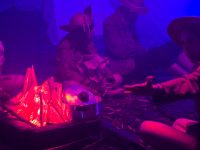One of the big problems for organizers of larp festivals – particularly those that bring together larps and larpers from different cultures, and/or people with little or no larping experience – is: how to describe the larps in ways that will be meaningful to participants who may come from a different larping background, or from no larping background at all?
This is something that the organizing team of The Smoke: London’s International Larp Festival tried to tackle. At The Smoke we always had a huge variety of content and an even huger variety of participants. We found quite quickly that asking designers and GMs to write descriptions of their larps, while essential, was sometimes of limited value to people who either didn’t understand the terms being used, or who understood them to mean different things to what was actually intended.
We decided to add a requirement that people submitting larps to the programme should, as well as describing the larp discursively, answer a set of questions that sought to establish firm and unambiguous statements about what taking part in the larp would involve. Asking this at submission allowed us to ensure a mix of larps on the programme, as well as making them clear to prospective participants.
Hopefully this will not only be useful for festival organizers. It may also be helpful to anyone who’s organizing a run of a chamber larp for their friends, or seeking to recruit participants for one: and perhaps also for participants who want to examine a little what it is that they do and don’t enjoy doing in larps, etc.
An example
This is taken from the website of the 2022 edition of the festival, for the larp 4–3 (Alessandro Giovannucci and Oscar Biffi):
ABOUT THE LARP
The city stops, gathered around the stadium. The derby splits it in two. In the locker room, eleven players prepare for so much more than just another game. On the other side of the wall, their long-time rivals. A ritual, a sacred space for the length of the match, only extinguished by the referee’s final blow on the whistle. And in between, some sublime moments and many ridiculous episodes.
In a word, football.
4–3 is all about teamplay and the match is a non verbal ritual of gestures and movement. But the result is determined by what happens in the locker room. As the athletes prepare to face yet another epic challenge, their stories and decisions interweave like a web of passes. Will they miss or score a goal?
PARAMETERS
| Physical contact | Not relevant for this larp; e.g. just standing in a room and talking |
| Romance and intimacy | Not relevant for the larp |
| Conflict and violence | Shouting and other intimidating actions not involving contact |
| Communication style | Half of the game is verbal, half non-verbal |
| Movement style | Jogging on the spot at your own pace and pass a ball |
| Characters | Players play facets of a personality, or something else that is human but less than a full character |
| Narrative control | There are random mechanics to establish the final score of the match |
| Transparency | Fully transparent – players will, or at least can, know absolutely everything in advance |
| Representation | The fictional space looks very unlike the play space, but players will use their imaginations |
| Play culture | Players are collaborating to achieve joint aims |
| Tone | Moderate |
Not the Mixing Desk
This approach is related to that of the Mixing Desk of Larp (Martin Nielsen and Martin Eckhoff Andresen), which uses a set of sliders to describe a larp design in terms of various properties.
The Mixing Desk itself was conceived as a design tool; and although it also has value in communicating the nature of the larp to prospective participants, this is not what it was designed to achieve. Also, the Mixing Desk is aimed at people who already have some understanding of the Nordic larp design space: the sliders are not necessarily going to be meaningful to people from other communities, or to newcomers.
We considered preparing a ‘mixing desk of submitting larps to international festivals’ or something like that, using a similar model but with sliders that were chosen to be clear and meaningful for our specific explanatory purpose. We decided not to go down this route, because we felt that a choice of textual parameters was more useful in this situation than a numeric/visual position on a slider.
This was partly in order to gain clarity – the difference between 4 and 6 out of 10 on a slider is not obvious, while the difference between ‘walking’ and ‘running’ is more so.
And it was partly because it allows possibilities that aren’t just along one linear direction. If there was a slider for ‘Level of physical activity’, should a larp that involves dancing set the slider higher or lower than one that involves running? Perhaps they are similar enough that the slider would be the same: but they are sufficiently different as experiences that we wanted to represent them separately.

Participants at The Smoke 2022, photo by Oliver Facey
The parameters
The questions asked, and the options offered for each, have evolved somewhat over the years that The Smoke has run, as we gradually refined the initially-crude system in the direction of being clearer and more helpful. No doubt there is still a lot of room for improvement, and perhaps readers will have thoughts of their own about what they might like to see changed, added, or removed.
We always took into consideration that we didn’t want to put too heavy a burden on the people who were submitting these forms. Otherwise, one could add any number of questions… There has to be a balance between usability for submitters, and usefulness for eventual participants. We don’t know if we’ve struck that balance in the right place.
Here are the 11 parameterized questions that were asked for The Smoke 2022, the explanatory text that accompanied each, and the options available. All include an ‘Other…’ option, to allow the submitter to write in something that’s not covered by the available options.
Of course, if your audience is different to The Smoke’s audience, some of these options (or even some of the questions) may not be applicable to you: or some may be missing. We’re explaining this here as our particular approach for this event; we’re not trying to say that it should be universal.
Physical contact
If relevant, the level of physical contact participants should generally be comfortable with to play the larp.
- Not relevant for this larp; eg. just standing in a room and talking
- Light contact; touching hands or forearms
- Moderate contact; eg. hugging, formal partner dancing
- Moving in contact; eg. rolling around on the floor together, contact improv, very close dancing
- Intense contact; intimate or forceful
- Other:
Romance and intimacy
How the larp handles themes of romance and intimacy. Put the level participants should generally be comfortable with to play the larp.
- Not relevant for the larp
Romantic themes but no player contact; eg. discussion of romance, illicit glances
Demonstrations of affection; eg. hugging, holding hands
Symbolic kissing or sex; eg. stage kisses, abstractly representing sex
Actual kissing or simulated sex; eg. dry humping
Other:
Conflict and violence
How the larp handles conflict and forceful play, if relevant. Put the level participants should be generally comfortable with to play the larp.
- Not relevant for this larp
- Themes of conflict, but not enacted by players; eg. quiet threats and vengeful stares
- Shouting and other intimidating actions not involving contact
- Pushing, grabbing, latex weapons, or other safe physically-forceful actions
- Other:
Communication style
How will participants be communicating with each other during play? If it’s a mix, choose ‘Other’ and explain.
- Silent
- Non-verbal sounds
- Minimal speech
- Lots of speech
- Singing or chanting
- Other:
Movement style
Choose the minimum level required, ie. participants can run but also it’s ok to walk, choose ‘Walking’. If it’s too complex for one choice, choose ‘Other’ and explain – this is primarily to gauge how accessible your larp is to people with restricted movement.
- Sitting or lying
- Walking
- Dancing
- Running or other vigorous movement
- Other:
Characters
Who creates the characters, and what are they like? Choose the nearest; or If it’s too complex for one choice, choose ‘Other’ and explain.
- There are no actual characters; participants play abstract entities, or similar
- Participants play facets of a personality, or something else that is human but less than a full character
- Participants create their own characters, in a workshop
- Participants build their characters around a predesigned skeleton or archetype
- Characters are fully predesigned
- Other:
Narrative control
Who is responsible for the direction of story? Choose the nearest; or If it’s too complex for one choice, choose ‘Other’ and explain.
- There is no story as such, it’s more like abstract activity
- The shape and direction of the story is entirely, or almost entirely, determined by participant choice
- Participants have some influence over story, but there is basically a script or structure that they’re within
- Intensely plotted and designed, but participants have freedom as to how to achieve their goals
- Heavily scripted, perhaps with predefined scenes whose outcomes are known
- Other:
Transparency
How important are secrets? Choose the nearest; or If it’s too complex for one choice, choose ‘Other’ and explain.
- Fully transparent – participants will, or at least can, know absolutely everything in advance
- Transparent design, but participants can create secrets during play and keep them from each other / reveal them when wished
- There are predesigned secrets that participants will have from each other
- There are predesigned secrets that the organizers will have from the participants
- There are predesigned secrets the organizers have from the participants , and also that the participants will have from each other
- Other:
Representation level
How does the physical reality of the room relate to the fiction? Choose the nearest; or If it’s too complex for one choice, choose ‘Other’ and explain.
- What you see is what you get: the space and fixtures etc are exactly as they seem
- The fictional space is pretty similar to the play space
- Scenery and props will be used to make the play space look something like the fictional space
- The fictional space looks very unlike the play space, but participants will use their imaginations
- The fictional space is so abstract that its physical representation isn’t important
- Other:
Play culture
How will participants be playing together? Almost all larps are collaborative to some extent, so take that as a given. Choose the nearest; or If it’s too complex for one choice, choose ‘Other’ and explain.
- Players are in direct opposition, p vs p
- Players are individually trying to achieve goals, such that not all can succeed
- Players are in rival factions, teams, etc, which are in some sort of competition for success
- Players are collaborating to achieve joint aims
- The concept of rivalry or cooperation between players doesn’t really apply
- Other:
Tone
What is the general tone of the larp and of the themes it covers? An ‘Intense’ larp might not be misery all the time, but will require participants to engage with serious or heavy material. Choose the nearest; or If it’s too complex for one choice, choose ‘Other’ and explain.
- Comedic
- Light-hearted
- Moderate
- Dramatic
- Intense
- Other:
In review
The Smoke’s organizing team built up the current set of parameters, as described here, over time, as we discovered what it was that people wanted to know about a larp. For example, the initial set of parameters didn’t include physical contact, romance and intimacy, or conflict and violence: these were added later, after feedback from festival participants and reflection from the organizers.
It is unavoidable that there is still an amount of subjectivity in the answers, based on the designer’s own larp experience. The difference between a moderate, dramatic, and intense tone is a matter of perspective: and the tone of the design doesn’t necessarily indicate the nature of the experience. If there is bleed-in, a relatively low key larp can feel intense. Similarly, quiet threats with a feeling of realism can feel more violent than an abstract fight with latex weapons: and whether this is the case might not always be in the control of the designers.
As a compromise between not asking for too much labor from people submitting larps (and indeed from those reading the resultant descriptions), and allowing participants to get a clear understanding of what they were likely to experience, our perception is that this system has been largely effective.
Cover photo: by Thomas Stephan on Unsplash






